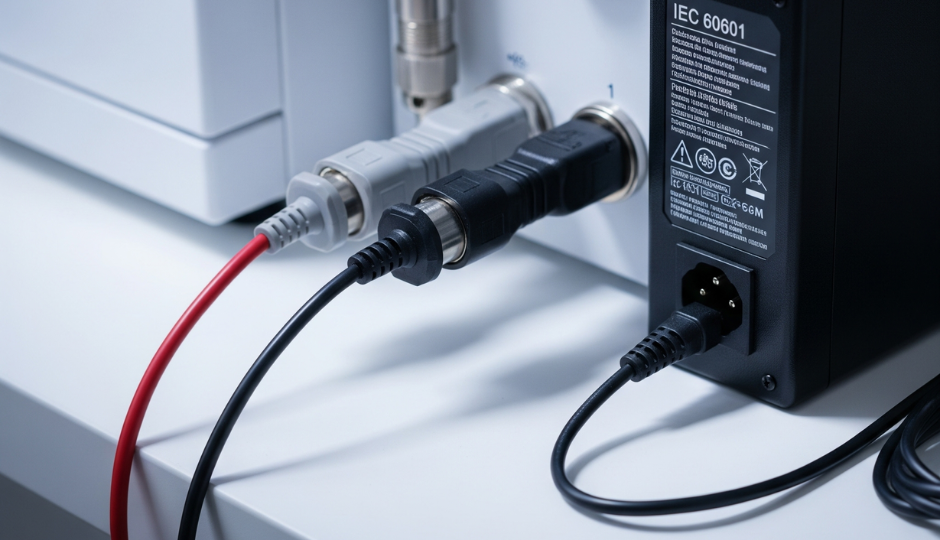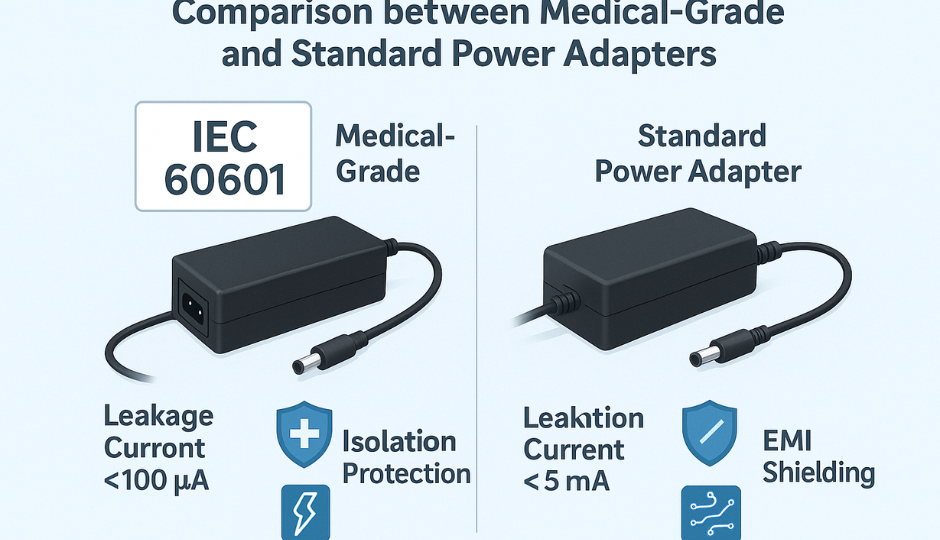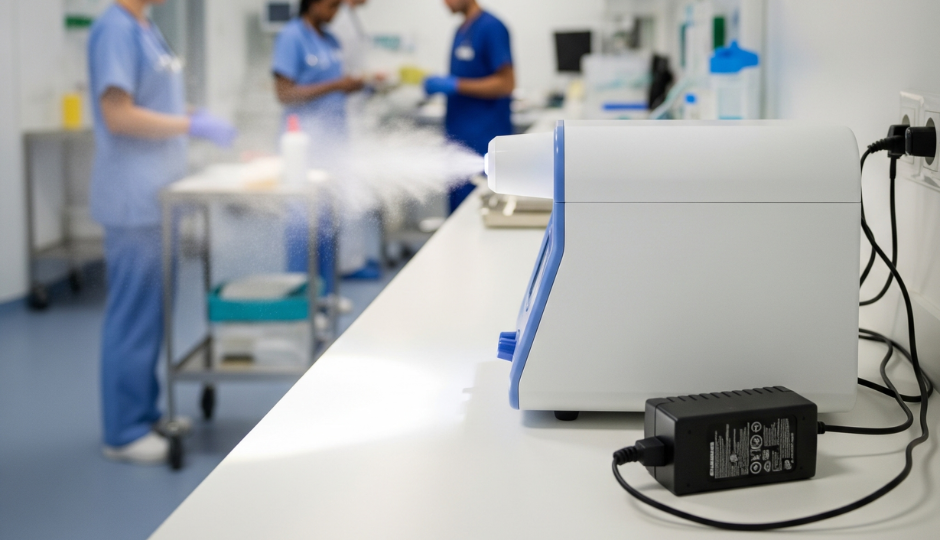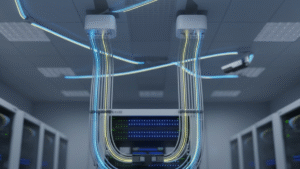If your ozone disinfection device is unstable or underperforming, the problem might not be the core technology—it could be your power adapter.
Yes, investing in medical-grade power supplies for ozone disinfection units ensures reliable performance, safety, and compliance with international standards, especially in medical or clinical environments where safety is non-negotiable.
When I started working with ozone disinfection systems, I quickly realized that many reliability issues stemmed not from the ozone generators themselves, but from the power supplies. Especially in medical-grade applications like dental clinics or surgical rooms, the equipment can’t afford even minor disruptions. That’s why I began replacing generic power adapters with certified medical-grade ones. The improvement was immediate—better ozone consistency, no overheating, and most importantly, peace of mind.
Why are medical-grade power supplies essential for ozone disinfection units?
If the goal is to ensure safe and uninterrupted sterilization, the quality of the power supply can’t be compromised.
Medical-grade power supplies offer electrical isolation, low leakage current, and compliance with strict safety standards such as IEC 60601, protecting both the device and its users.

Dive deeper: What makes a power supply “medical-grade”?
A medical-grade power adapter is not just a fancier version of a regular one. It’s built to meet specific requirements that are critical for clinical safety and equipment stability. Here’s a breakdown of what makes these adapters different:
Key Differences Between Medical-Grade and Standard Power Supplies
| Feature | Medical-Grade Adapter | Standard Commercial Adapter |
|---|---|---|
| Compliance Standard | IEC 60601-1, 60601-1-2 | IEC 62368, 60950 |
| Leakage Current | ≤ 100 µA (for patient-contact devices) | Up to 500 µA or more |
| Isolation Protection | 2 x MOPP (Means of Patient Protection) | Basic or none |
| EMC/EMI Shielding | Advanced (Class B) | Basic (Class A or B) |
| Risk Management | Required by ISO 14971 | Not mandatory |
The cost may be higher, but the value of risk reduction and compliance in medical use cases cannot be overstated. Devices used around patients or inside clinical settings are often required by law or certification bodies to use these adapters. Choosing the wrong adapter could mean failing compliance checks or, worse, harming users.

How does it affect ozone concentration and disinfection quality?
When power fluctuates, your ozone sterilizer can’t perform consistently—and that’s a big problem.
Stable and regulated power input from a medical-grade adapter ensures that ozone output remains consistent, which directly affects sterilization efficiency.
Dive deeper: Power stability impacts ozone output accuracy
I worked on a project where we used ozone sterilizers in a dental clinic. We noticed inconsistent sterilization results, especially during peak working hours. After troubleshooting, we found the generic adapter supplied with the unit was dipping below the needed voltage threshold. This disrupted the corona discharge process, which is how ozone is produced. Once we switched to a medical-grade adapter with precise voltage regulation and better shielding from EMI, the problem disappeared.
Consistent ozone generation depends on a constant electrical charge across the ozone tube or plate. If the adapter sags under load or emits electrical noise, the output fluctuates. That leads to unreliable sterilization cycles and potential microbial survival.
Using a medical-grade adapter eliminates this problem. These adapters use higher-quality components, have better shielding, and undergo more stringent performance testing. The result is a power delivery profile that perfectly matches the precision needed for medical ozone systems.
What environments require medical-grade power supplies?
There are places where cutting corners is simply not an option.
Any ozone sterilizer used in hospitals, dental clinics, elderly care facilities, or laboratories must use medical-grade power supplies due to safety and legal compliance.

Dive deeper: Legal and operational risks in clinical use
Let me be blunt—if you’re running ozone-based disinfection units in regulated environments and you’re using off-the-shelf power adapters, you’re playing with fire. The IEC 60601 standard isn’t just a suggestion. It’s enforced by regulatory bodies and required for insurance coverage, CE/UL certification, and hospital procurement.
In elderly care homes and surgical prep rooms, power surges or leakage currents can interfere with sensitive equipment or cause safety issues for vulnerable patients. Medical-grade adapters limit leakage current to safe levels, typically under 100 μA. That’s crucial if your device is operating near patient beds or integrated into life-critical systems.
Failing to use a certified power adapter could mean product recalls, denied insurance claims, or even legal liability in the case of patient injury. From a business standpoint, it’s a risk no one should take.
Is it worth the cost compared to standard adapters?
It might cost more upfront, but it saves you from bigger losses down the line.
Medical-grade power supplies reduce equipment failure, meet compliance requirements, and improve brand reputation, making them a smart long-term investment.
Dive deeper: ROI and long-term benefits
Some might argue that medical-grade adapters are too expensive—sometimes double the price of a standard one. But what’s the cost of a product failure? Or worse, a failed certification test just before your shipment deadline?
I’ve worked with clients who had to recall entire batches because they didn’t factor in the correct power supply. I’ve also seen companies pass audits smoothly and enter new medical markets just because their adapters were certified. That one difference unlocked whole new channels.
If you’re developing ozone sterilizers for export or want to partner with hospitals and clinical labs, this investment is not optional—it’s strategic. Think of it like this: the adapter is a small component, but its failure can bring down your entire product. Paying a little more now ensures you don’t pay a lot more later.
Conclusion
Medical-grade power supplies offer real, measurable value for ozone sterilizers in clinical use—better safety, better performance, and better trust.




